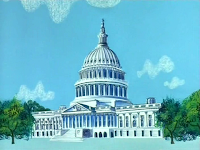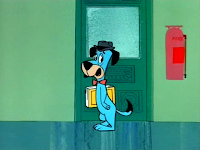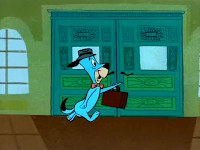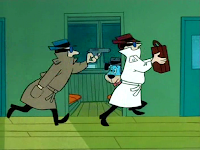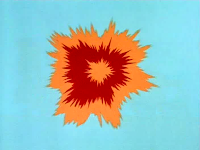Produced and Directed by Joe Barbera and Bill Hanna.
Credits: Animation – Brad Case; Layout – Don Sheppard; Backgrounds – Dick Thomas; Written by Mike Maltese; Story Director – Alex Lovy; Titles – Art Goble; Production Supervision – Howard Hanson.
Voice Cast: Snooper, Blabber, Martian on phone – Daws Butler; Mailman, Martian, Door, Monkey – Don Messick.
Music: Jack Shaindlin, Phil Green.
First Aired: week of June 12, 1961.
Episode: Quick Draw McGraw Show M-041, Production J-120.
Plot: Snooper and Blabber travel to Mars to capture a thieving monkey.
In the 1940s, there was something advertised on the radio called ‘Serutan.’ Listeners were reminded “It’s ‘natures’ spelled backwards.” Such a silly concept was just begging to be spoofed. Pretty soon, Jack Benny, Bob Hope and other radio comedians were doing routines about words spelled backwards. Evidently Mike Maltese thought the idea was funny, too, because he uses it as a running gag in this cartoon, though he beats it into the ground a bit.
Maltese also grabs a concept he used over on the Augie Doggie series, namely Augie talking in some gibberish language to outer space creatures he has somehow befriended (Augie and dear old dad end up on Mars in “Vacation Tripped” in 1962). In this case, Blabber has somehow come in contact with Martians along the way. The odd thing is the Martians don’t speak backwards. So why all the reverse English in the cartoon?
Hanna-Barbera fans may be interested in this cartoon from a design standpoint. Part of it is set in outer space, so it’s a little reminiscent of The Jetsons. True, The Jetsons wasn’t an outer space show, but there was a futurism/life-in-space cross-over in the 50’s and early ‘60s. We posted a bit about it HERE. Don Sheppard came up with the designs, based on Alex Lovy’s storyboards from Maltese’s thumbnail drawings. Whether Sheppard worked on The Jetson is unclear—credits for individual episodes have been gone for ages—but it’s possible.
![]()
Here are Snoop and Blab riding a “saucer cycle.” You can picture this on The Jetsons can’t you?
![]()
Wasn’t there a disintegrator gun on a Jetsons’ episode, too? (I don’t mean the ‘80s revival; the show ended in 1963 as far as I’m concerned). Note the portrait of the King of Mars on the wall in the background.
![]()
And here’s the spacecraft that arrived on Earth to take Snooper and Blabber to Mars to capture an Earth monkey that landed there and stole the royal ruby from the Martian king’s palace.
![]()
Let’s show off a few more of Sheppard’s settings painted by Dick Thomas. The private eye-ball found in most of the Snooper and Blabber cartoons is on a window this time. It’s nicely framed by a tree.
![]()
![]()
And Snooper and Blabber’s office is run-down. Even the bulb in the overhead light is a warped shape. Snooper has a picture of a cop on the wall for some reason.
![]()
![]()
Brad Case is the animator. A couple of times he indulges in the outline/brush strokes drawings when characters move off scene, like in “Crew Cat” we reviewed earlier.
And, as usual, the cartoon features Maltese’s silly and punny dialogue, mainly from the mouth of Snooper. Snoop says, besides “What in carnation” (borrowed from Ed Gardner’s Archie, the main inspiration for Snooper’s voice) and the catchphrases “Drop that ybur in the name of the Private Eye Telescope and Chowder Society!” and “Elementary school, me dear Blab”:
● Ah, spring-time! When we can remove our shoes and run barefoot through fields of beautiful avunculars.
● Leave us not be nave (a Warners Bros fan can tell us which cartoon Bugs Bunny mispronounced “naïve.”)
● A ‘1207’? That means “Old Ladies Stealin’ Kumquats.”
● Uh, ask him to stop with the rock ‘n’ roll and give us a clue (after excited Martian jumps up and down).
● Help! I’m being attacked by Martian saucers (after monkey throws plates at him). Blab: Poor Snoop. He’s bein’ dishwacked.
● Just in the nicholas of time.
There are two dialogue short scenes with a robotic voice at the door of the Layor Ecalap. “Wipe your feet,” the voice helpfully tells our heroes, adding “This is a recording.” The “recording” line must have been fairly new around 1960. My guess is it was invented when automated phone systems came into being.
So Snooper and Blabber get taken to Mars, get the Royal Ruby from the earth monkey who crash-landed on the planet (and, presumably, the 12,000,000-crymolian reward) but Blab stays behind because the Martians made him their leader. (What about the old leader in the portrait?) Snoop grants him a month’s leave of absence without pay. Blab expresses his gratitude, kind of like in a routine between Jack Benny and Rochester.
The cartoon ends with the kind of pun I hated as a kid. It shows the monkey in a trenchcoat, sitting on a pile of peanuts. Snoop tells someone on the phone that the monkey’s filling in for Blab “And, what’s more, he works for peanuts.” Said young I to the TV set: “Well, I could come up with that one.” As a cartoon viewer, I like clever puns, stuff I’d never think of. If the pun is going to be tired and obvious, it’s best to make fun of it, like Tex Avery used to in his cartoons.
Looking at the production numbers available on a couple of internet sites, this cartoon was the last Snooper and Blabber to feature music from the Capitol Hi-Q (Phil Green) and Langlois Filmusic (Jack Shaindlin) libraries. And it’s the only Hanna-Barbera cartoon with stock music recently released on DVD. We get a good portion of the happy, skippy cue that opens the cartoon, including the introduction, and the full version of Shaindlin’s “Asinine.” The first two cues take up almost half the cartoon.
0:00 - Snooper and Blabber Main Title theme (Curtin, Hanna, Barbera).
0:27 - jaunty bassoon and skipping strings (Shaindlin) – Snoop and Blab in office, phone scene.
2:16 - ASININE (Shaindlin) – Blab points, space ship, land on Mars, Blab talks to Martian, monkey runs into building, Snoop and Blab skid to a stop.
3:32 - GR-255 PUPPETRY COMEDY (Green) – “Just hold it a sec,” conversation at door, monkey behind dishes.
4:10 - SIX DAY BICYCLE RACE (Shaindlin) – Snoop runs down hall, “…the royal Ruby,”
4:31 - GR-98 BY JIMINY! IT’S JUMBO BRIDGE No 2 (Green) – “That’s layor ybur…”
4:40 - SIX DAY BICYCLE RACE (Shaindlin) – Monkey with gun, saucer cycle scene, crash land.
5:47 - GR-248 STREETS OF THE CITY (Green) – Blab on top of Snoop, Blab and monkey chat, Blab stays, Snoop on phone.
7:00 - ‘Fireman’ (Shaindlin) – Shot of monkey, Snoop “peanuts” joke.
7:09 - Snooper and Blabber End Title theme (Curtin).
Credits: Animation – Brad Case; Layout – Don Sheppard; Backgrounds – Dick Thomas; Written by Mike Maltese; Story Director – Alex Lovy; Titles – Art Goble; Production Supervision – Howard Hanson.
Voice Cast: Snooper, Blabber, Martian on phone – Daws Butler; Mailman, Martian, Door, Monkey – Don Messick.
Music: Jack Shaindlin, Phil Green.
First Aired: week of June 12, 1961.
Episode: Quick Draw McGraw Show M-041, Production J-120.
Plot: Snooper and Blabber travel to Mars to capture a thieving monkey.
In the 1940s, there was something advertised on the radio called ‘Serutan.’ Listeners were reminded “It’s ‘natures’ spelled backwards.” Such a silly concept was just begging to be spoofed. Pretty soon, Jack Benny, Bob Hope and other radio comedians were doing routines about words spelled backwards. Evidently Mike Maltese thought the idea was funny, too, because he uses it as a running gag in this cartoon, though he beats it into the ground a bit.
Maltese also grabs a concept he used over on the Augie Doggie series, namely Augie talking in some gibberish language to outer space creatures he has somehow befriended (Augie and dear old dad end up on Mars in “Vacation Tripped” in 1962). In this case, Blabber has somehow come in contact with Martians along the way. The odd thing is the Martians don’t speak backwards. So why all the reverse English in the cartoon?
Hanna-Barbera fans may be interested in this cartoon from a design standpoint. Part of it is set in outer space, so it’s a little reminiscent of The Jetsons. True, The Jetsons wasn’t an outer space show, but there was a futurism/life-in-space cross-over in the 50’s and early ‘60s. We posted a bit about it HERE. Don Sheppard came up with the designs, based on Alex Lovy’s storyboards from Maltese’s thumbnail drawings. Whether Sheppard worked on The Jetson is unclear—credits for individual episodes have been gone for ages—but it’s possible.

Here are Snoop and Blab riding a “saucer cycle.” You can picture this on The Jetsons can’t you?

Wasn’t there a disintegrator gun on a Jetsons’ episode, too? (I don’t mean the ‘80s revival; the show ended in 1963 as far as I’m concerned). Note the portrait of the King of Mars on the wall in the background.

And here’s the spacecraft that arrived on Earth to take Snooper and Blabber to Mars to capture an Earth monkey that landed there and stole the royal ruby from the Martian king’s palace.

Let’s show off a few more of Sheppard’s settings painted by Dick Thomas. The private eye-ball found in most of the Snooper and Blabber cartoons is on a window this time. It’s nicely framed by a tree.


And Snooper and Blabber’s office is run-down. Even the bulb in the overhead light is a warped shape. Snooper has a picture of a cop on the wall for some reason.


Brad Case is the animator. A couple of times he indulges in the outline/brush strokes drawings when characters move off scene, like in “Crew Cat” we reviewed earlier.
And, as usual, the cartoon features Maltese’s silly and punny dialogue, mainly from the mouth of Snooper. Snoop says, besides “What in carnation” (borrowed from Ed Gardner’s Archie, the main inspiration for Snooper’s voice) and the catchphrases “Drop that ybur in the name of the Private Eye Telescope and Chowder Society!” and “Elementary school, me dear Blab”:
● Ah, spring-time! When we can remove our shoes and run barefoot through fields of beautiful avunculars.
● Leave us not be nave (a Warners Bros fan can tell us which cartoon Bugs Bunny mispronounced “naïve.”)
● A ‘1207’? That means “Old Ladies Stealin’ Kumquats.”
● Uh, ask him to stop with the rock ‘n’ roll and give us a clue (after excited Martian jumps up and down).
● Help! I’m being attacked by Martian saucers (after monkey throws plates at him). Blab: Poor Snoop. He’s bein’ dishwacked.
● Just in the nicholas of time.
There are two dialogue short scenes with a robotic voice at the door of the Layor Ecalap. “Wipe your feet,” the voice helpfully tells our heroes, adding “This is a recording.” The “recording” line must have been fairly new around 1960. My guess is it was invented when automated phone systems came into being.
So Snooper and Blabber get taken to Mars, get the Royal Ruby from the earth monkey who crash-landed on the planet (and, presumably, the 12,000,000-crymolian reward) but Blab stays behind because the Martians made him their leader. (What about the old leader in the portrait?) Snoop grants him a month’s leave of absence without pay. Blab expresses his gratitude, kind of like in a routine between Jack Benny and Rochester.
The cartoon ends with the kind of pun I hated as a kid. It shows the monkey in a trenchcoat, sitting on a pile of peanuts. Snoop tells someone on the phone that the monkey’s filling in for Blab “And, what’s more, he works for peanuts.” Said young I to the TV set: “Well, I could come up with that one.” As a cartoon viewer, I like clever puns, stuff I’d never think of. If the pun is going to be tired and obvious, it’s best to make fun of it, like Tex Avery used to in his cartoons.
Looking at the production numbers available on a couple of internet sites, this cartoon was the last Snooper and Blabber to feature music from the Capitol Hi-Q (Phil Green) and Langlois Filmusic (Jack Shaindlin) libraries. And it’s the only Hanna-Barbera cartoon with stock music recently released on DVD. We get a good portion of the happy, skippy cue that opens the cartoon, including the introduction, and the full version of Shaindlin’s “Asinine.” The first two cues take up almost half the cartoon.
0:00 - Snooper and Blabber Main Title theme (Curtin, Hanna, Barbera).
0:27 - jaunty bassoon and skipping strings (Shaindlin) – Snoop and Blab in office, phone scene.
2:16 - ASININE (Shaindlin) – Blab points, space ship, land on Mars, Blab talks to Martian, monkey runs into building, Snoop and Blab skid to a stop.
3:32 - GR-255 PUPPETRY COMEDY (Green) – “Just hold it a sec,” conversation at door, monkey behind dishes.
4:10 - SIX DAY BICYCLE RACE (Shaindlin) – Snoop runs down hall, “…the royal Ruby,”
4:31 - GR-98 BY JIMINY! IT’S JUMBO BRIDGE No 2 (Green) – “That’s layor ybur…”
4:40 - SIX DAY BICYCLE RACE (Shaindlin) – Monkey with gun, saucer cycle scene, crash land.
5:47 - GR-248 STREETS OF THE CITY (Green) – Blab on top of Snoop, Blab and monkey chat, Blab stays, Snoop on phone.
7:00 - ‘Fireman’ (Shaindlin) – Shot of monkey, Snoop “peanuts” joke.
7:09 - Snooper and Blabber End Title theme (Curtin).






































































































.png)
.png)
.png)
.png)
.png)
.png)
.png)
.png)


